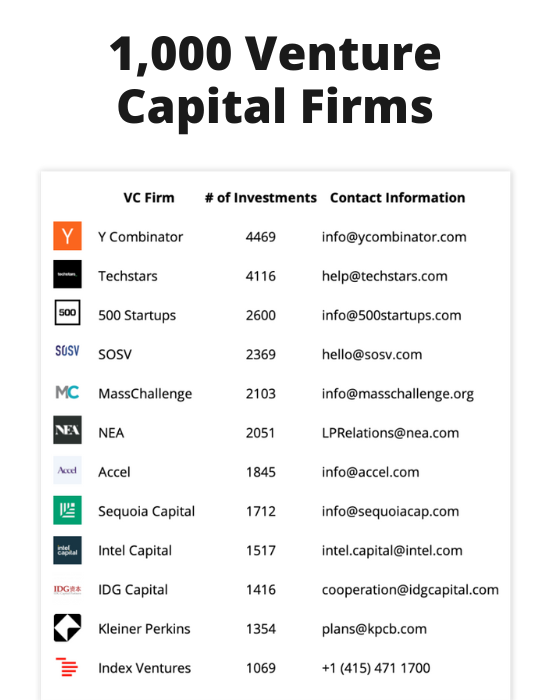
Sheet
1,000 VC Firms
Information about the countries, cities, stages, and industries they invest in, as well as their contact details.
Get the Sheet for $50
The easiest way to run a startup project into the ground is to spend time and resources on something the market doesn’t need. According to our research, 34% of startups fail because of a lack of product-market fit. This applies to all kinds of innovative projects, including SaaS startups.
Idea validation is becoming standard in the startup world. Without question, the most reliable way to validate an idea is to run pre-sales, as it provides hard evidence people are willing to put down money for your offering.
This guide will give you a detailed breakdown of how to pre-sell your SaaS to ensure you are on the right path to product-market fit.
Why Pre-selling is The Best Way to Validate a SaaS Idea
Customer interviews, waitlists, and other soft ways to validate your idea are inferior to pre-sales because of one simple reason: they leave space for the niceness gap.
The niceness gap is the difference between the people telling you that your idea is good and the actual number of people who are willing to buy your product.
Since people don’t want to be mean and deflate your enthusiasm, they are willing to overstate how much they like your idea and how likely they are to use it. Because of this, even after running customer interviews, you can hardly feel safe your idea has been validated.
This is not the case with pre-sales. Money in the bank is hard data.
Of course, having objective proof of the validity of your idea is not only suitable for your level of certainty – it can be beneficial for fundraising, finding co-founders, partners, etc.
Furthermore, the feedback would be more honest if you asked for money. If someone declines to pay you, they would be inclined to tell you why and point you in the right direction to improve your idea.
Before You Start Pre-Selling your SaaS
Here are the steps you need to undertake to be ready to pre-sell your SaaS:
Create Some Visuals and Mockups to Help You Pre-sell
Selling a naked idea without anything to showcase is very hard. People need to imagine what you are offering them before they can confidently make a purchase decision.
That’s why mockups are a fundamental pre-sell strategy for your software. They are orders of magnitude easier to create than a working prototype while simultaneously being equally effective at visualizing the whole idea.
UI/UX sketching apps like Sketch, Figma, or inVision are the perfect tools to show customers what you plan to build. You can quickly and easily create a clickable prototype as part your SaaS presale.
For example, this SaaS for web designers made $1225 in pre-sales (25 copies) by creating a mockup of their idea.
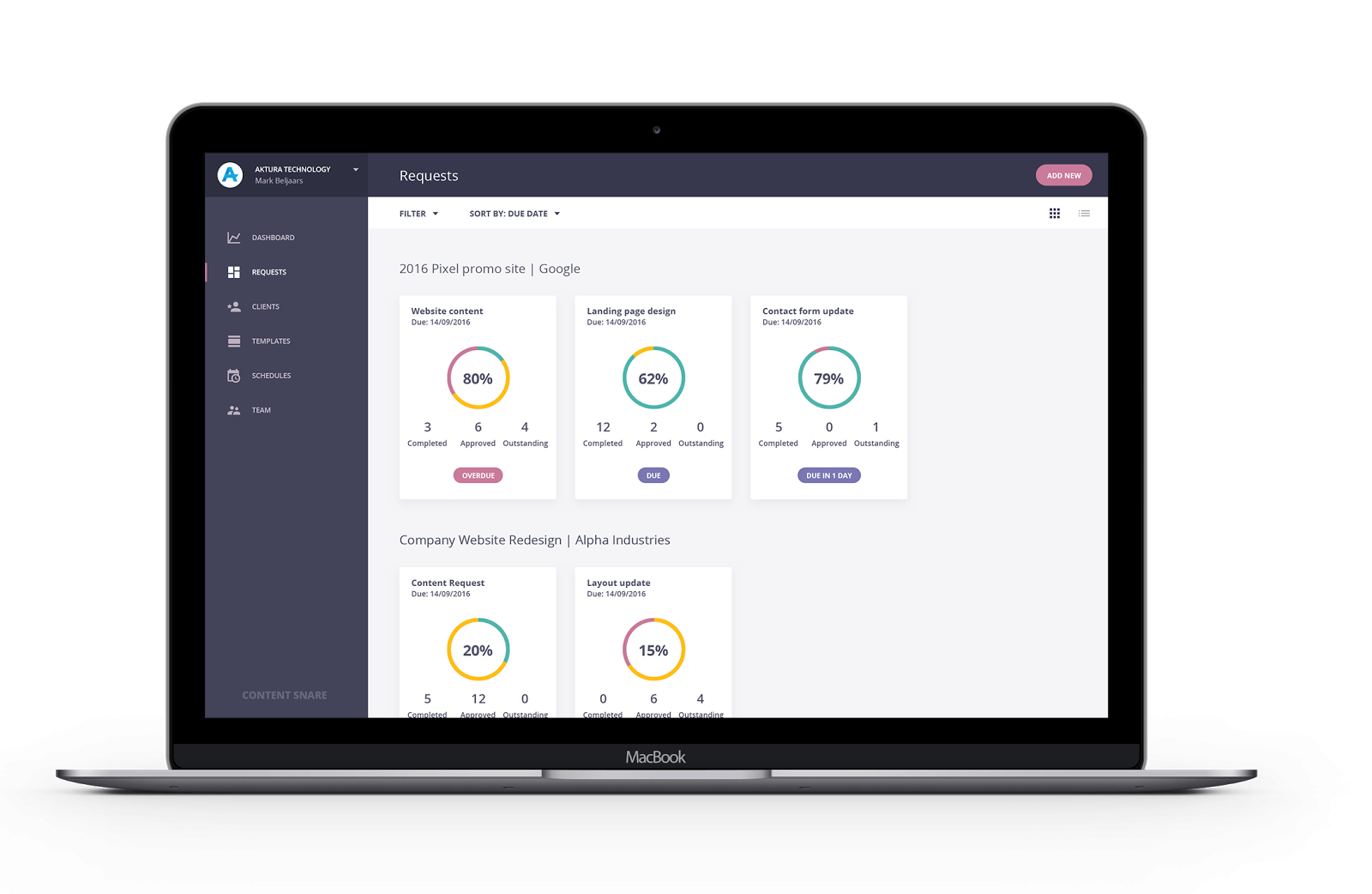
Once done, you can animate your prototype with an animation tool (even simply “Keynote”) to create a video demo of the product.
For example, Brian Casel, founder of Ops Calendar, recorded a screencast video walkthrough explaining the product concept after animating some mockups with Keynote. This video was the main asset that secured him $3k in pre-sales in 6 weeks.
You need to decide on how much you’d want to polish your prototype from a design standpoint. A prototype that looks well-made might help you attract more presales, but it might not justify the extra effort if you are planning to run tests of multiple iterations.
Build a Pre-selling Site Where You Take Pre-orders
Once your prototype is ready, you need a landing page to help you sell it.
Creating a good landing page is more of a science than an art. Being overly creative can confuse your visitors, which would make them bounce rather than investigate further. That’s why it’s best to adhere to well-established industry practices.
Generally speaking, you want your landing page to include 4 main sections.
- Hero image + extremely short and accurate description. People need to get what you’re offering at a glance. The explainer video could be placed here if it is concise – otherwise, put it further down the landing page.
- Call to action: Pre-order button with a price (ideally at a discount).
- Testimonials: Social proof is essential to give people the needed certainty to commit to a purchase decision. You can use testimonials from past clients, endorsements from people, press you’ve been featured in, and past successes in business.
- Last but not least – the mockup and explainer video.
To do this easily, you can use No-Code tools like Carrd and Webflow. Stan Rymkiewicz, the founder of Orapa, shared in this short interview how he used different no-code tools to create a landing page and started selling immediately.
Craft an Excellent Deal for Early-supporters
Since the product isn’t ready and the customers will have to wait to access a working version, pre-sold products are generally offered with a hefty discount. They include various bonuses, such as customer support and closer involvement in building the solution.
Offering a great deal is important because if you don’t provide an incentive to purchase now, many of your (future) customers will prefer to wait until your product is done. This way, you wouldn’t be able to judge if your validation test is successful and if you should build the SaaS product in the first place.
Here are some discount and bonus ideas:
- Lifetime deal. Headlime’s founder, Danny Postma, sold 200 lifetime deals in 48 hours (making him $16k), leveraging his 9k Twitter following and an email waiting list.
- Discounted plans. Simple.ink’s founder successfully pre-sold over $1,000 for his new SaaS idea by offering a discounted yearly plan and leveraging his website’s audience.
- Customer support through direct calls with the founder. It’s a win-win situation since it’ll also give you direct access to your future customers for customer interviews.
- Free migration or installation service to lower the barrier to entry (especially if your SaaS deals with a lot of data)
- Free consultancy (tailored individual attention for helping your first customers solve the problem you are targeting)
Scarcity could be another great tactic to nudge more hesitant potential customers towards purchasing decisions by creating FOMO.
Strategies to generate scarcity:
- Make the offer to a limited number of customers. PriceUnlock’s founder limited the offer to 100 customers to generate scarcity and minimize refund costs if the project didn’t work out and they couldn’t fulfill their presale promise.
- Price increases as sales are made. Steph Smith used a tiered pricing strategy for her book, Doing Content Right, which meant the price increased as more people bought. This triggered scarcity and also helped her find the right price point/discounting mechanisms later.
- Invitations to have access to the tool. Superhuman and Hey.com were built through an invite-only strategy. This is an excellent solution if you want to build “behind closed doors” while at the same time benefiting from invaluable customer feedback, retaining the possibility for a big launch event.
- There are other strategies like countdowns and using numbers to show popularity.
Note: It’s essential to prioritize trust above marketing tactics.
Be Prepared for Objections, Deal With Them Clearly
People are naturally going to be skeptical. That is normal – you are asking for their money with nothing to sell (yet). It’s up to you to earn their trust!
- State refund policy: Offer no-hassle refunds if possible to show trust. PriceUnlock is a great example: they offered hassle-free refunds and were willing to cover Stripe’s refund fee to give their consumers 100% confidence that they were not risking anything.
- Write an extensive FAQ: A great way to do it is to write down any customer question that comes up more than once and add it to the FAQ. Remember that a lot of people expect to see all relevant information on your website.
- Create social proof: Use the first customers/fans’ reviews to craft that social proof. You can also use testimonials of previous products you’ve built.
If you’d like to learn advanced pre-sell strategies and step-by-step processes I use to help each of my students validate their startup ideas, check out my course “Pre-Sell to Validate”.
8 Strategies to Get Pre-Sales for your SaaS
Once the groundwork is laid, you need to go to work, and you need to do it smartly:
1) Leverage your Audience
Leveraging an audience is one of the most commonly used pre-sell strategies in the SaaS industry. If you have an audience on social media that is following you, you are in a great position to run validation tests and turn your followers into customers.
One of the best things you can do in this position is let your followers tell you what product/service/software to build.
Pat Walls did this well. Before creating his online course “Lean SEO”, he had been sharing helpful information about his Programmatic SEO efforts for many months and how he was growing Starter Story’s organic traffic. He tweeted stats and strategies, shared numbers in his monthly reports, etc.
One day, he tweeted:
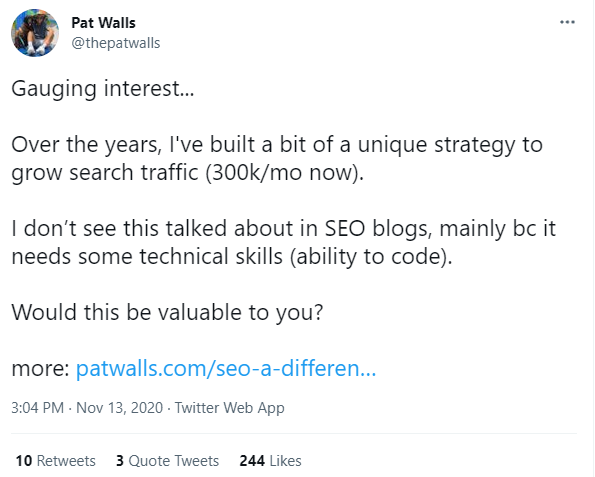
A lot of people showed interest. Then he asked if he should do a course; the feedback was positive, so he started working on the outline and started pre-selling it.
Pat kept building in public over the following weeks. This had resulted in $10k in pre-sales before he launched.
Of course, Pat’s approach was made possible by his big Twitter audience.
Another excellent example of creators leveraging their audiences as part of their pre-sell strategies is the founder of “CSS for JS Developers”. He leveraged his 50k Twitter following to presell $50k worth of copies in 10 minutes, reaching $500k within a week.
Keep in mind that what kind of people are following you plays a significant role in this. E.g., Pat was able to sell the SEO course because he was followed by a lot of people interested in SEO.
Moreover, a social media following is great for this, but the most invaluable resource by far is an active mailing list because of the much higher engagement percentage.
2) Niche Communities
Having direct involvement in a niche community with a high concentration of likely users of your (future) product is a great idea.
When interacting with such communities, the number one rule is to become an organic, valuable member of the community rather than interacting with it to advertise your offering. You need to help people without expecting anything in return and genuinely interact with people who could benefit from the solution you are offering on a one-on-one basis.
For example, suppose someone is not happy with a competitor. In that case, this is an excellent opportunity to win a customer while genuinely solving a problem (i.e., without being spammy) while at the same time understanding the issues that your target users are facing.
Of course, this takes more effort than engaging your audience, but unlike the previous tactic, it’s practically available to anyone, not only those with an audience.
Many niche communities are hosted in Facebook groups. Content Snare’s founder shared in this post how he engaged in relevant FB groups to get 25 pre-sales for his SaaS.
When pre-selling Ops Calendar, Brain Casel also made use of this strategy. He looked on Twitter, FB groups, and Quora for people asking for solutions and advice on content calendars in the previous 6-12 months.
He founded 20-30, to whom he sent a message pitching them his SaaS. He got 6-7 conversations from there, which he turned into 4-5 sales calls. Besides, these calls made him realize the frustrations with the existing solutions and that his target customers weren’t hard to reach.
3) Publishing and Promoting Content
You can create a blog with content that is directly related and useful to your target audience. While this can help with SaaS presales, the value of this strategy will keep increasing with time as your content starts ranking organically through some SEO.
In the early idea generation and validation stages, it’s crucial to actively promote your content because it would be too early for SEO to have an effect.
A great example of this strategy in action is the case of Encharge.io, which started publishing lots of content related to its target audience and earned $3,950 in preorder revenue.
They wrote a lengthy guide on “How I launched, marketed and sold my first SaaS – HeadReach” and marketed it heavily to SaaS people, entrepreneurs, and marketers, which were the potential audience for their new marketing automation tool.
The post included some lead magnets asking people to leave their emails. After collecting 500 emails, they created a landing page with a hypothesis for a “Marketing automation software built for SaaS people”. They sent an email blast to their list, which resulted in 50 orders.
The All-In-One Newsletter for Startup Founders
Every week, I’ll send you the top 10 startup news and resources and an analysis of a failed and a hot company. Join +30,000 other startup founders!
Engineering as marketing is creating valuable tools (calculators, widgets, browser extensions, micro-sites, etc.) to get your company in front of the eyes of potential customers.
While this approach is among the more costly pre-sell strategies out there as it requires developers’ time, it definitely can help you stand out from your competitors, who use regular content as lead magnets, and can result in an ongoing stream of traffic if the mini-tool is valuable to the users.
The most significant benefits of engineering-as-marketing are:
- It doesn’t feel like marketing.
- The tools provide repeated usefulness (content isn’t generally re-consumed, but tools can be). Repeated visits give more significant opportunities to make an impression, collect a lead, or sell.
- It’s not a competitive acquisition channel yet (at least not as content marketing).
- It’s pretty easy to build such tools if you have developers in your team.
- No technical background is required for many cases because of the advancement of no-code tools (I.e., the marketing people can create some tools themselves).
- It can give you organic traffic to your website, and you can send people to other pieces of content or landing pages.
- Last but not least, it can give you high-quality backlinks (especially if you get press coverage). This can help you increase the domain strength of your website, making it much easier to rank your other pieces of content in Google for relevant keywords.
We were recently contacted by a software factory called UpTech, which had created a tool called Startup Blow Up, which randomly suggested reasons why your startup would fail.
We liked the idea and shared the tool in our newsletter. They got +75 clicks, which may have resulted in leads for their software services.
If they had created a piece of content on the causes of startup failure, we probably wouldn’t have shared it, as we already have posted on the topic, as well as dozens of other blogs writing about it. Engineering-as-marketing allowed them to differentiate.
5) Guest-Posting
Guest posting is a great tactic that could have two significant benefits for an early-stage project:
- First, it allows you to leverage an established audience. This is extremely valuable because building your audience takes years, making it an unsuitable tactic if you want to validate and test a new idea through pre-sales sooner rather than later.
- The backlinks from guest posting can help you grow the domain strength of your blog, which can have positive long-term effects on actually building your audience.
Of course, the obvious drawback is that every piece of content you publish on another blog (or podcast) is a piece of content you are not posting on your own. That said, this is not a big problem if you plan your content intelligently:
- Evergreen content that has a chance to rank on Google goes on your blog.
- Narrative-driven, interest-grabbing content (that wouldn’t rank on Google because it doesn’t answer a specific query) goes on other blogs and links to your content or landing pages when appropriate.
Leo Widrich, Buffer’s co-founder, made great use of this strategy. He wrote 150 guest posts during Buffer’s pre-launch stage, which helped the social media scheduling app gain +100k customers.
6) Cold-Outreach
Reaching out to potential clients and business partners might seem highly inefficient in the age of scalable communication and marketing through social media (especially if you have a low customer lifetime value that doesn’t justify one-on-one sales).
In a way, however, it is one of the most powerful tools of any early-stage project. The main reason is that it allows you to gain first-hand experience with how various stakeholders perceive your business and offers. This is invaluable feedback in the validation stages, so not doing cold outreach is a big mistake.
Stan Rymkiewicz sent 100+ cold emails when validating his business idea for Orapa. He’d pitch the product, get on a call, and try to sell it. He got around ten yearly subscription purchases in this way. These subscriptions included a 90-day guarantee and a 60% discount on average.
We also employed a cold outreach strategy for validating and pre-selling Scouth, our productized service offering remote talent scouting. Our cold outreach strategy centered on finding clients on Twitter:
We started by researching the competition on Twitter and found a tweet from someone interested in hiring overseas staff who had asked the competitor an unanswered question.
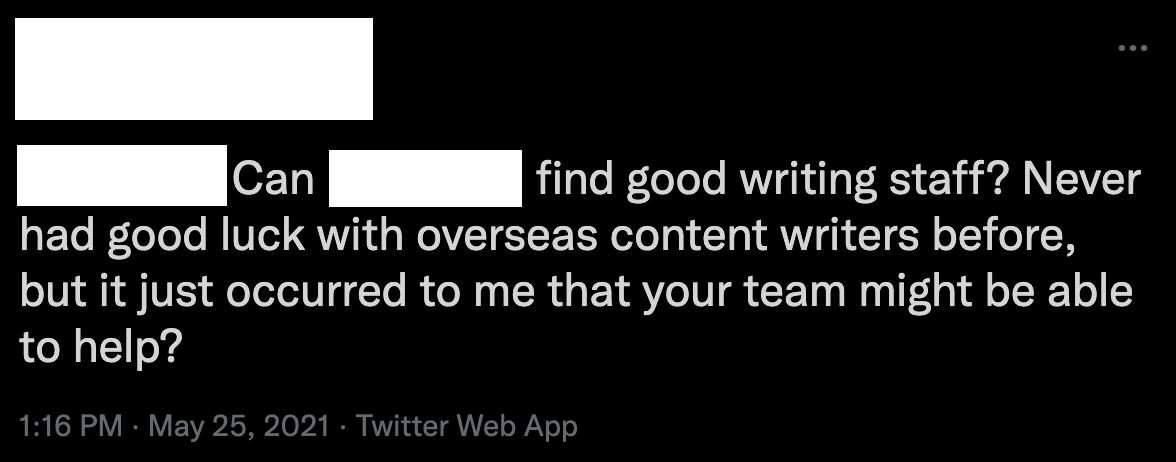
We sent an email to that person:
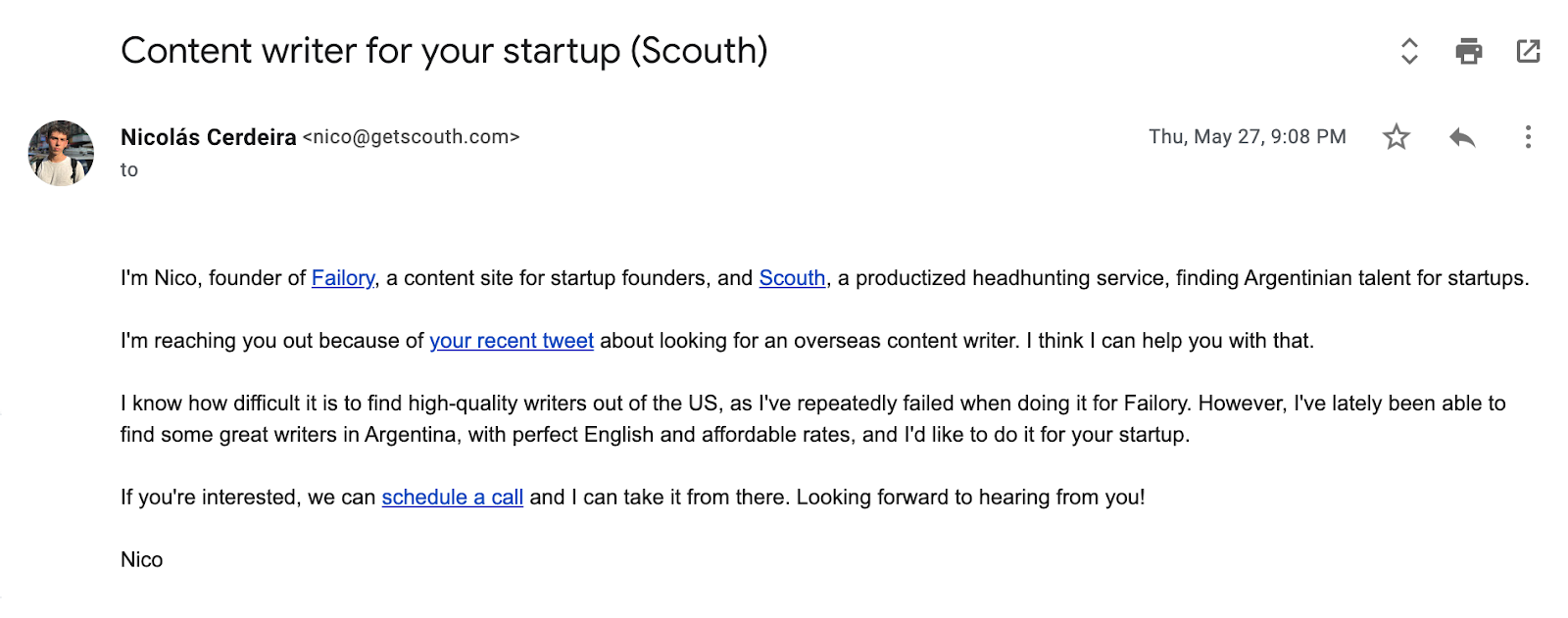
And it resulted in a new client.
We could also have found someone asking for technical support, new functionalities, or a refund through similar efforts and employed the same strategy.
7) Run Ads
The benefit of running paid ads during the validation phase is that you shouldn’t worry too much about the unit economics of the activity.
Even if your client’s lifetime value is lower than your acquisition costs, which would make paid ads a lousy strategy for scaling your business, this doesn’t make it a wrong approach for validating your concept.
If you manage to get pre-purchases from such efforts, this would indicate interest in your offering and would be a positive signal for moving forward, even if this means abandoning paid ads in the later stages of your business.
Here are a couple of ad strategies to help you run your ads in a way that maximizes pre-selling your SaaS:
- Make an ad promoting your product name to start ranking on searches right away (before Google can index and rank your page organically).
- Promote a lead magnet rather than the actual product/newsletter.
- Retarget people who have visited your pre-order page but didn’t purchase.
- Bid on competitor keywords.
- Focus on keywords with high-selling intent.
- Create a few campaigns with different headlines to find which converts the best.
Headlime’s founder used Google AdWords to validate his SaaS idea. He ran various ad campaigns with different titles. Along with tweeting, this resulted in a pre-launch email list of 350 subscribers.
Besides that, he was able to A/B test the performance of different headlines, which he could then use for his landing pages.

Kettle and Fire’s founder made use of Bing Ads instead. He built a landing page where users could buy bone broth. He purchased $50 worth of Bing ads and got some sales. In 2 weeks, he made $500.
8) Attend or Run an Event
Finally, a great way to test your offering is to ask people in person. You can do that by attending events (e.g., industry conferences) with a high concentration of your potential customers.
In a way, this is a strategy that has some of the benefits of guest blogging and cold outreach:
- You are burrowing the audience of the event.
- You are interacting one-on-one with potential clients/partners with helps you judge their level of interest and their willingness to commit.
Spiffy’s founder made excellent use of this strategy. He built his SaaS on top of another platform and assisted an event related to this platform. He shared with us:
“The spark that got us started was going to major industry conferences and showing off the mock-ups. They felt authentic on a phone as people scrolled even though it was just a picture… the software we started as an addon had a very tight-knit community, and what we were doing was thought to be impossible.”
Of course, organizing and running your event (e.g., a webinar) with the same goal is also possible, but this is easier to do if you have a well-developed network.
For example, Aazar Ali Shad, Ecomply.io’s founder, put together 3 webinars on different topics and promoted them on relevant FB groups. The results were 5 pre-launch customers for $560 in MRR.
Conclusion
We hope that the strategies mentioned above and tactics for pre-selling your SaaS are helpful!
When you plan to implement any of them, consider that depth is usually better than scope. It’s sometimes tempting to try too many things at once, but not putting enough effort into your chosen tactics can vastly reduce their effectiveness.
Do the prep work, choose one to three strategies you think you’ll be able to excel at, and generate some pre-sales!




